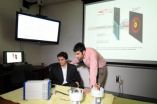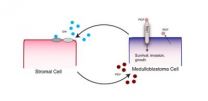(Press-News.org) The adsorption of ions in microporous materials governs the operation of technologies as diverse as water desalination, energy storage, sensing and mechanical actuation. Until now, however, researchers attempting to improve the performance of these technologies haven't been able to directly and unambiguously identify how factors such as pore size, pore surface chemistry and electrolyte properties affect the concentration of ions in these materials as a function of the applied potential.
To provide the needed information, researchers at the Georgia Institute of Technology and the Oak Ridge National Laboratory have demonstrated that a technique known as small angle neutron scattering (SANS) can be used to study the effects of ions moving into nanoscale pores. Believed to be the first application of the SANS technique for studying ion surface adsorption in-situ, details of the research were reported online Jan. 31, 2013, in the journal Angewandte Chemie International Edition.
Using conductive nanoporous carbon, the researchers conducted proof-of-concept experiments to measure changes in the adsorption of hydrogen ions in pores of different sizes within the same material due to variations in solvent properties and applied electrical potential. Systematic studies performed with such a technique could ultimately help identify the optimal pore size, surface chemistry and electrolyte solvent properties necessary for either maximizing or minimizing the adsorption of ions under varying conditions.
"We need to understand this system better so we can predict the kind of surface chemistry required and the kinds of solvents needed to control the levels of ion penetration and adsorption in pores of different sizes," said Gleb Yushin, an associate professor in the Georgia Tech School of Materials Science and Engineering. "Understanding these processes better could lead to the development of improved energy storage, water purification and desalination systems. This new experimental methodology may also give us paths to better understand ion transport in biological systems and contribute to the development of improved drugs and artificial organs."
The research was supported partially by the U.S. Army Research Office, the Georgia Institute of Technology and the Oak Ridge National Laboratory (ORNL).
"The advantage of neutron scattering is that it can be used to study real systems," said Yushin. "You can study most electrode materials and electrolyte combinations as long as they have a high sensitivity for neutron scattering."
Yushin and his collaborators – Georgia Tech graduate research assistant Sofiane Boukhalfa, and Oak Ridge scientists Yuri Melnichenko and Lilin He – conducted the research using ORNL's High Flux Isotope Reactor, which produces a beam of high-energy neutrons. Their experimental setup allowed them to immerse activated carbon fabric samples – each sample containing pores of different sizes – in different electrolyte materials while varying the applied electrical potential.
By measuring how the neutron beam was scattered when it passed through the carbon fabric and electrolytes, the researchers could determine how the solvent, pore size and electrical potential affected the average ion concentration in the carbon material samples.
"You can learn whether the ions get adsorbed into small pores or large pores by simply comparing the changes in the neutron scattering," Yushin explained. "This experimental technique allows us to independently change the surface chemistry to see how that affects the ion concentrations, and we can use different solvents to observe how the interaction between electrolyte and pore walls affects the ion adsorption in pores of different sizes. We can further identify exactly where the ion adsorption takes place even when no potential is applied to an electrode."
Earlier work in this area had not provided clear results.
"There have been multiple prior studies on the pore size effect, but different research groups worldwide have obtained contradictory results depending on the material selection and the model used to determine the specific surface area and pore size distribution in carbon electrodes," Yushin said. "Neutron scattering should help us clarify existing controversies. We have already observed that depending on the solvent-pore wall interactions, either enhanced or reduced ion electro-adsorption may take place in sub-nanometer pores."
In their experiments, the researchers used two different electrolytes: water containing sulfuric acid and deuterium oxide – also known as heavy water – which also contained sulfuric acid. The two were chosen for the proof-of-concept experiments, though a wide range of other hydrogen-containing electrolytes could also be used.
Now that the technique has been shown to work, Yushin would like to expand the experimentation to develop better fundamental understanding about the complex interactions of solvent, ions and pore walls under applied potential. That could allow development of a model that could guide the design of future systems that depend on ion transport and adsorption.
"Once you gain the fundamental knowledge from SANS experiments, predictive theoretical models could be developed that would guide the synthesis of the optimal structures for these applications," he said. "Once you clearly understand the structure-property relationships, you can use materials science approaches to design and synthesize the optimal material with the desired properties."
Information developed through the research could lead to improvements in supercapacitors and hybrid battery-capacitor devices for rapidly growing applications in hybrid electrical vehicles, energy efficient industrial equipment, smart grid-distributed energy storage, hybrid-electric and electrical ships, high-power energy storage for wind power and uninterruptible power supplies.
INFORMATION:
This research was partially supported by the Georgia Institute of Technology and the U.S. Army Research Office under contract number W911NF-12-1-0259. The research at ORNL's High Flux Isotope Reactor was sponsored by the Laboratory Directed Research and Development Program and the Scientific User Facilities Division, Office of Basic Energy Sciences, U.S. Department of Energy. The conclusions are those of the authors and do not necessarily reflect the official positions of the U.S. Army Research Office or the Department of Energy.
CITATION: Boukhalfa, S., et al., "Small-Angle Neutron Scattering for In Situ Probing of Ion Adsorption Inside Micropores." Angew. Chem. Int. Ed (2013). http://www.dx.doi.org/10.1002/anie.21209141.
Neutron scattering provides data on adsorption of ions in microporous materials
Improving energy storage
2013-02-28
ELSE PRESS RELEASES FROM THIS DATE:
Physicists demonstrate the acceleration of electrons by a laser in a vacuum
2013-02-28
Accelerating a free electron with a laser has been a longtime goal of solid-state physicists.
David Cline, a distinguished professor in the UCLA Department of Physics and Astronomy, and Xiaoping Ding, an assistant researcher at UCLA, have conducted research at Brookhaven National Laboratory in New York and have established that an electron beam can be accelerated by a laser in free space.
This has never been done before at high energies and represents a significant breakthrough, Cline said, adding that it also may have implications for fusion as a new energy source. ...
New protein quality method provides important information on sustainable diet
2013-02-28
Rosemont, IL (February 27, 2013) – A groundbreaking report by an Expert Consultation of the Food and Agriculture Organization of United Nations (FAO) has recommended a new, advanced method for assessing the quality of dietary proteins.
The report, "Dietary protein quality evaluation in human nutrition", recommends that the Digestible Indispensable Amino Acid Score (DIAAS) replace the Protein Digestibility Corrected Amino Acid Score (PDCAAS) as the preferred method of measuring protein quality. The report recommends that more data be developed to support full implementation, ...
Mutation location is the key to prognosis
2013-02-28
HOUSTON – (Feb. 28, 2013) – The three most important factors in real estate are location, location, location, and the same might be said for mutations in the gene MECP2, said researchers at Baylor College of Medicine and the Jan and Dan Duncan Neurological Research Institute (NRI) at Texas Children's Hospital in a report in the journal Cell.
"Where a mutation occurs can affect the severity of the symptoms of the disease," said Dr. Huda Zoghbi, professor of molecular and human genetics at BCM and director of the NRI. Zoghbi, corresponding author of the report, found the ...
UCLA study could explain why some people get zits and others don't
2013-02-28
The bacteria that cause acne live on everyone's skin, yet one in five people is lucky enough to develop only an occasional pimple over a lifetime. What's their secret?
In a boon for teenagers everywhere, a UCLA study conducted with researchers at Washington University in St. Louis and the Los Angeles Biomedical Research Institute has discovered that acne bacteria contain "bad" strains associated with pimples and "good" strains that may protect the skin.
The findings, published in the Feb. 28 edition of the Journal of Investigative Dermatology, could lead to a myriad ...
Action video games boost reading skills
2013-02-28
Much to the chagrin of parents who think their kids should spend less time playing video games and more time studying, time spent playing action video games can actually make dyslexic children read better. In fact, 12 hours of video game play did more for reading skills than is normally achieved with a year of spontaneous reading development or demanding traditional reading treatments.
The evidence, appearing in the Cell Press journal Current Biology on February 28, follows from earlier work by the same team linking dyslexia to early problems with visual attention rather ...
Fighting GM crop vandalism with a government-protected research site
2013-02-28
Genetically modified (GM) crops have been a source of great controversy—particularly in Europe—but acts of vandalism and associated security costs have made scientific evidence about the health and ecological impacts of those crops hard to come by. A Swiss government-protected field site dedicated for use in GM crop studies could serve as an example to other European countries interested in pursuing crop biotechnology, according to an article published in Trends in Biotechnology, a Cell Press publication, on February 28.
The protected field site will now enable research ...
Study identifies growth factor essential to the most common malignant pediatric brain tumor
2013-02-28
A multi-institutional team led by Massachusetts General Hospital (MGH) researchers has identified a molecular pathway that appears to be essential for the growth and spread of medulloblastoma, the most common malignant brain tumor in children. In their report in the Feb. 28 issue of Cell, they show that blocking this pathway – which involves interactions between tumor cells and the surrounding tissues – leads to regression of all four molecular subtypes of medulloblastoma in several mouse models.
"Our finding that a pathway carrying signals from host cells to tumor cells ...
How did early primordial cells evolve?
2013-02-28
VIDEO:
L-form bacteria undergoes cell division. The time scale is in minutes.
Click here for more information.
Four billion years ago, soon after the planet cooled enough for life to begin, primordial cells may have replicated and divided without protein machinery or cell walls, relying instead on just a flimsy lipid membrane. New research on bacteria examines exactly how these primitive cells could have evolved without such crucial structures. While the vast majority of bacteria ...
Animas' development of a first-generation closed loop insulin delivery system progresses
2013-02-28
WEST CHESTER, Pa., February 28, 2013 – Animas Corporation announced today positive results from the second phase of human clinical trials of a first-generation, closed-loop insulin delivery system in development, designed to predict a rise or fall in blood glucose and correspondingly increase, decrease, suspend and resume insulin delivery. The data were presented at the Advanced Technologies & Treatments for Diabetes (ATTD) Conference in Paris, France.
The feasibility study of the predictive Hypoglycemia-Hyperglycemia Minimizer (HHM) System* in development was conducted ...
The birth of a giant planet?
2013-02-28
An international team led by Sascha Quanz (ETH Zurich, Switzerland) has studied the disc of gas and dust that surrounds the young star HD 100546, a relatively nearby neighbour located 335 light-years from Earth. They were surprised to find what seems to be a planet in the process of being formed, still embedded in the disc of material around the young star. The candidate planet would be a gas giant similar to Jupiter.
"So far, planet formation has mostly been a topic tackled by computer simulations," says Sascha Quanz. "If our discovery is indeed a forming planet, then ...
LAST 30 PRESS RELEASES:
Scalable and healable gradient textiles for multi‑scenario radiative cooling via bicomponent blow spinning
Research shows informed traders never let a good climate crisis go to waste
Intelligent XGBoost framework enhances asphalt pavement skid resistance assessment
Dual-function biomaterials for postoperative osteosarcoma: Tumor suppression and bone regeneration
New framework reveals where transport emissions concentrate in Singapore
NTP-enhanced lattice oxygen activation in Ce-Co catalysts for low-temperature soot combustion
Synergistic interface engineering in Cu-Zn-Ce catalysts for efficient CO2 hydrogenation to methanol
COVID-19 leaves a lasting mark on the human brain
Scientists use ultrasound to soften and treat cancer tumors without damaging healthy tissue
Community swimming program for Black youth boosts skills, sense of belonging, study finds
Specific depressive symptoms in midlife linked to increased dementia risk
An ‘illuminating’ design sheds light on cholesterol
Who is more likely to get long COVID?
Study showcases resilience and rapid growth of “living rocks”
Naval Research Lab diver earns Office of Naval Research 2025 Sailor of the Year
New Mayo-led study establishes practical definition for rapidly progressive dementia
Fossil fuel industry’s “climate false solutions” reinforce its power and aggravate environmental injustice
Researchers reveal bias in a widely used measure of algorithm performance
Alcohol causes cancer. A study from IOCB Prague confirms damage to DNA and shows how cells defend against it
Hidden viruses in wastewater treatment may shape public health risks, study finds
Unlock the power of nature: how biomass can transform climate mitigation
Biochar reshapes hidden soil microbes that capture carbon dioxide in farmland
Reducing saturated fat intake shows mortality benefit, but only in high-risk individuals
Manta rays create mobile ecosystems, study finds
Study: Mixed results in using lipoic acid to treat progressive multiple sclerosis
Norbert Holtkamp appointed director of Fermi National Accelerator Laboratory
New agentic AI platform accelerates advanced optics design
Biologists discover neurons use physical signals — not electricity — to stabilize communication
Researchers discover that a hormone can access the brain by hitchhiking
University of Oklahoma researcher awarded funding to pursue AI-powered material design
[Press-News.org] Neutron scattering provides data on adsorption of ions in microporous materialsImproving energy storage




